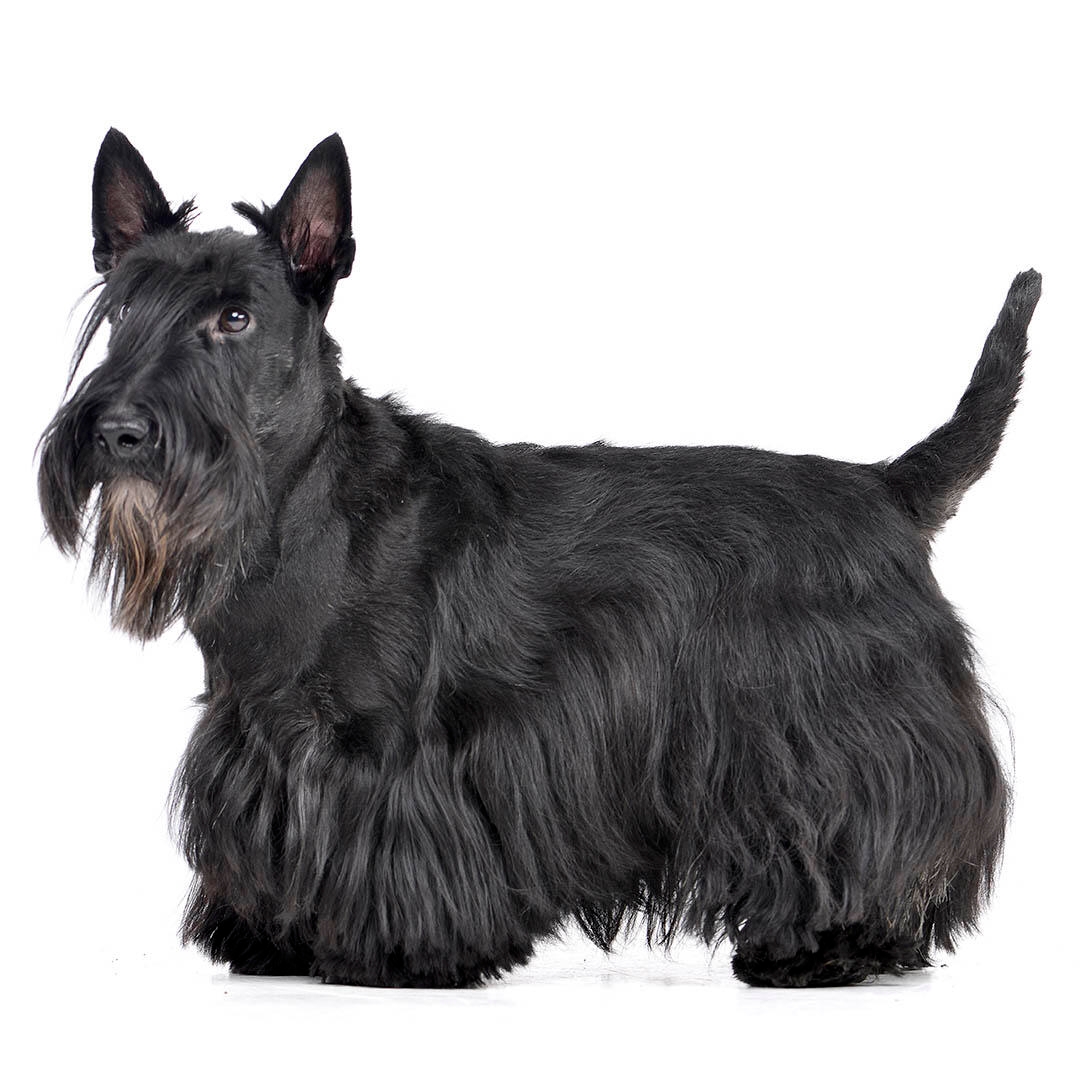
| Family-friendly: | 4/5 |
| Exercise needs: | 4/5 |
| Easy to train: | 1/5 |
| Tolerates being alone: | 3/5 |
| Likes other pets: | 4/5 |
| Energy level: | 4/5 |
| Grooming needs: | 2/5 |
| Shedding: | 2/5 |
The Scottish Terrier breed can suffer from:
- Patellar luxation
- Von Willebrand's disease¹ which is where a dog produces insufficient or faulty clotting factors which can result in uncontrolled bleeding.
- Scottie cramp which is a hereditary disorder which causes the muscles in the legs to temporarily cramp.
Priority Kennel Club health schemes and testing:
None but there are several recommended schemes that the Kennel Club recommends which can be found here.
¹P. J. Venta, 'Mutation causing von Willebrand's disease in Scottish Terriers', 2008, Journal of Veterinary Internal Medicine
Scottish Terriers are frequently described as bold, lion-hearted, loyal and serious, but also dour, aloof, and reserved. Whilst primarily a companion and show dog today, the Scottish Terrier is very much a terrier, with all the feist and independent spirit one should expect.
With kind, patient training and motivation, the Scottie can be a cheerful, loyal and affectionate family friend to those they live with and knows well, but don’t expect them to be gushing and effusive with strangers.
| Family-friendly: | 4/5 |
| Exercise needs: | 4/5 |
| Easy to train: | 1/5 |
| Tolerates being alone: | 3/5 |
| Likes other pets: | 4/5 |
| Energy level: | 4/5 |
| Grooming needs: | 2/5 |
| Shedding: | 2/5 |
Although known as the Scottish Terrier since 1879, the Scottie has had several earlier names, including the Aberdeen Terrier, the Hard-Coated Scotch Terrier and the Die-Hard or Wire-Haired Terrier.
Descended from the ancestral Highland Terrier, and closely related to the West Highland White Terrier, the Scottish Terrier was a working dog, bred to go to ground and take on any pest necessary. Their short legged, powerful muscular build and hard coat meant they were excellent in this role.
If you’ve got terrier experience and enjoy the challenge of getting these independent minded types working with you rather than against you, the Scottish Terrier may be your ideal dog. Though small, they are incredibly powerful and as such are suited to fairly fit and active owners, and they will need some grooming at home too. Scotties possess the fire and spice of dogs much bigger than they really are, so the best Scotties are trained as if they’re a big dog, and handled and managed sensitively. Scotties do not love everyone (human or canine) so its important you’re able to manage who your dog meets and interacts with. Better suited to homes without children, or with older, sensible teenagers.
Scottish Terriers are highly adaptable in their physical exercise requirements, but do require a good balance of mental versus physical. This is a clever, sharp minded breed who will enjoy scent-based games and problem solving as well as walks of all durations once fit but will need at least an hour every day.
As a small breed the Scottie does not require vast, expansive housing, however a secure garden and access to peaceful yet interesting walks will be necessary. This is a breed that can be kept happily in town or country, but they will need quiet, secure spaces to run, sniff and unwind, particularly if kept in busy towns.
Small dogs have a fast metabolism, meaning they burn energy at a high rate, although their small stomachs mean that they must eat little and often. Small-breed foods are specifically designed with appropriate levels of key nutrients and smaller kibble sizes to suit smaller mouths. This also encourages chewing and improves digestion.
To retain the hard, weatherproof coat, the Scottish Terrier must be hand stripped three or four times a year. This is something you can learn to do yourself, or have done professionally. Their legs, head and body can be clipped.
Grooming their faces and beard and checking between toes/pads for foreign bodies should be done daily, with the rest of the body done a couple of times a week.
The Scottish Terrier is a strong minded and independent breed, so whilst they can be trained to a high level you will need to employ positive reinforcement and ensure you remain interesting and motivating. If bored, the Scottish Terrier will find their own amusement.
An outlet for their natural desire to hunt small vermin, in the form of tug toys and soft toys is a must, and good socialisation with other dogs and other species from an early age is vital.
Raised kindly with respectful children, the Scottish Terrier can be a good family dog, they are however not inclined to effusive greetings with strangers, so will need time and patience if asked to add new people to their social group.
While many dogs are traditionally thought of as being good with children, all dogs and children need to be taught to get on with and respect each other, and be safe together. Even so, dogs and young children should never be left alone together and adults should supervise all interactions between them.